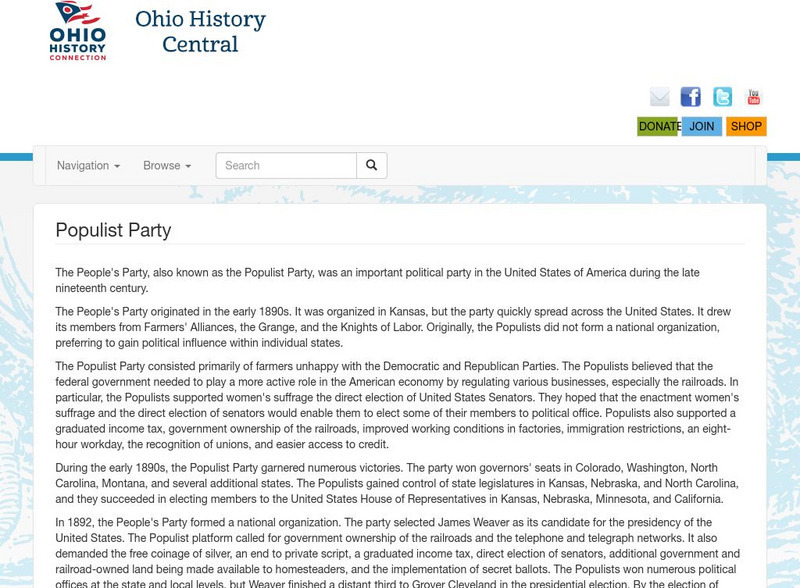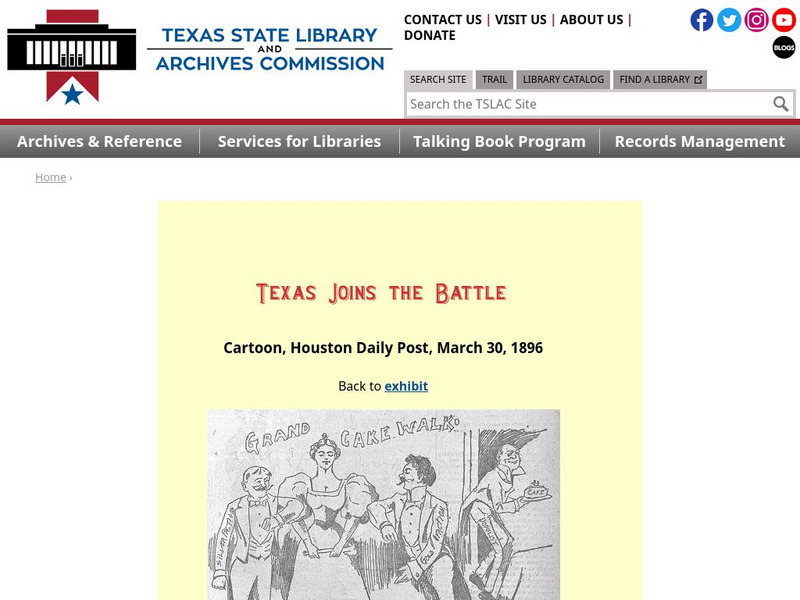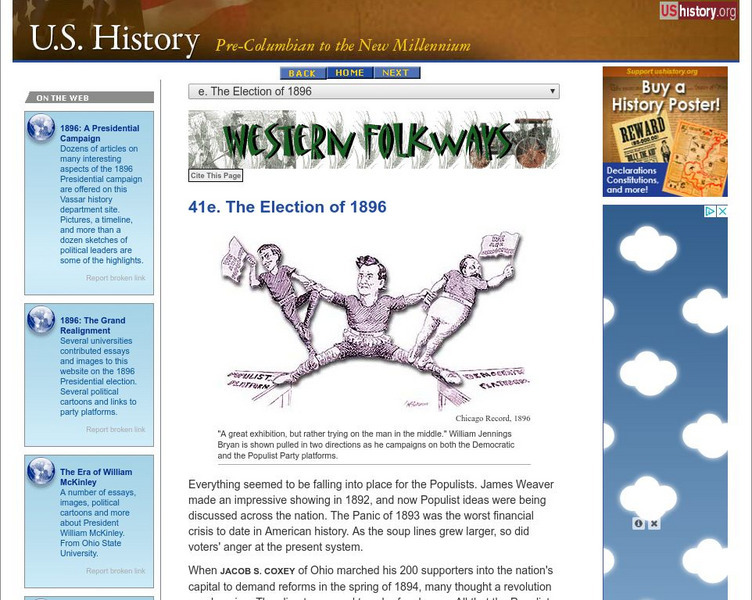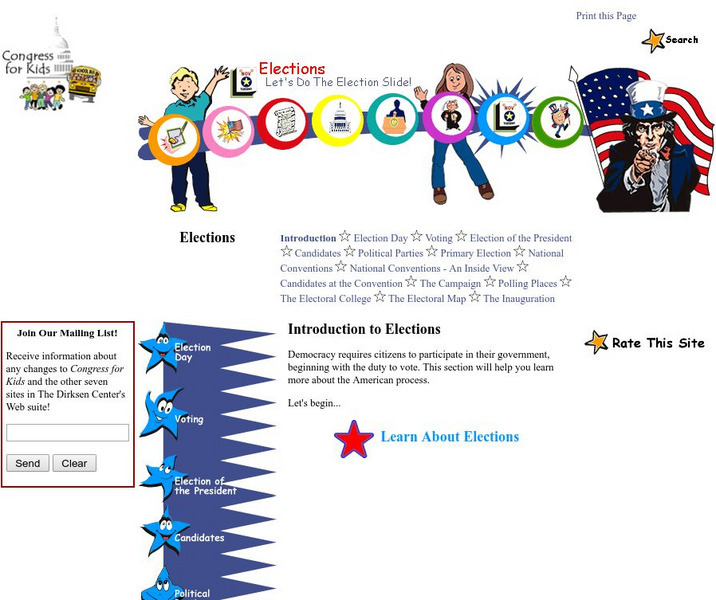Ohio History Central
Ohio History Central: Populist Party
The Populist Party was one of the more successful third parties, at least in state politics. Read about its platform on the national and state levels in the 1890s.
Harp Week
Harp Week: The Presidential Elections: 1880 Cartoon List
This fabulous site compiles political cartoons from Harper's Weekly for the campaing of 1880. The cartoons are drawn by Thomas Nast, and each cartoon is thoroughly explained. A great resource.
University of Groningen
American History: Outlines: Agrarian Distress and the Rise of Populism
Article outlines the rise of the Populist Movement in the U.S. as a result of a declining economy, agrarian distress and dissatisfaction with American politics in late 19th Century.
University of Maryland
University of Maryland: For All the World to See: Emory Douglas
Emory Douglas led a graphic visual campaign expressing the story of the Black Panther Party.
University of Virginia
Miller Center at Uva: u.s. Presidents: Franklin Pierce: The American Franchise
Read about the political party leanings of immigrants in the 1850s and the backlash against immigrants as reflected in political platforms.
A&E Television
History.com: How the South Helped Win the American Revolution
British commanders attempted to reverse their floundering fortunes by launching a campaign in the South. There the British would find not just crops such as tobacco, rice and indigo that were vital to their economy, but stronger Loyalist...
Curated OER
National Park Service: Biographical Sketches: Warren Harding
This concise article about Warren G. Harding gives information about his early life, how he got into politics, and his election as 29th president. There is brief mention of his domestic and foreign policies.
Vassar College
Vassar College: 1896: The Populist Party
This great resource from 1896, A Website of Political Cartoons from Vassar College discusses "The Rise of Populism" to "The End of Populism--or Not?"
University of California
The History Project: Ideas and Strategies of the Woman Suffrage Movement
The campaign for woman suffrage in the U.S. began with the Seneca Falls Convention in 1848. Sixty years later, however, women could vote in only four states: Colorado, Utah, Idaho and Wyoming. In 1910 the state of Washington voted nearly...
New York Times
New York Times: On This Day: Electoral College Controversy 1876
Thomas Nast's political cartoon from a Harper's Weekly 1877 edition plus a description of the dispute over the election of 1876.
A&E Television
History.com: How Us Presidents Have Communicated With the Public From the Telegraph to Twitter
From carefully staged speeches to radio to Twitter, U.S. presidents have always leveraged the cutting edge to connect directly with voters. Two centuries before Twitter, U.S. presidents understood the power of communicating directly with...
Other
Landmark Cases: United States v. Nixon (1974)
This is a great resource for teaching about this key Supreme Court case that dealt with the issue of executive privilege, and became known as the Watergate Scandal. Included is the complete text of the opinion.
Library of Congress
Loc: Primary Source Set: Women's Suffrage
A collection of primary sources dealing with women's suffrage.
Other
I Side With: 2016 Presidential Election: Quiz
Website designed to help voters decide which candidate best supports their interests. Students can take a quiz to find out their affiliation.
Texas State Library and Archives Commission
Texas State Library and Archives Commission: Texas Joins the Battle: Cartoon, Houston Daily Post, March 30, 1896
Here is a political cartoon showing showing the split between those who favored the gold standard and those favoring the silver standard, and how the Populist Party took advantage of that split. Learn what this means by taking a look at...
Other
Project Vote Smart: Homepage
Project Vote Smart provides an excellent page of links related to issues which are of interest in American politics.
Independence Hall Association
U.s. History: The Election of 1896
Read about the election of 1896 which had one candidate representing two political parties, and the other candidate who did not campaign. See what people supported the Democratic candidate and why. Find out who was elected and who...
Library of Congress
Loc: Presidential Election of 1960
What made the election of 1960 so different? Some political analysts call this election a turning point in American politics. Here's a brief overview of the election and questions to answer.
National Women's Hall of Fame
Women of the Hall: Geraldine Ferraro
Read about the life of the first woman to be nominated by a major political party for the candidacy of Vice President of the United States. Inducted into the Woman's Hall of Fame in 1994.
Other
The Battle of Princeton
The Battle of Princeton follows the Battle of Trenton in the New Jersey Campaign. Read a detailed history of the event here.
Social Studies for Kids
Social Studies for Kids: How the President Is Elected
Learn how the President of the United States is elected. Read how we choose candidates, how they campaign, how they are nominated, and what role the Electoral College plays in our elections.
The Dirksen Congressional Center
Congress for Kids: Elections
Here's a great presentation on Elections for younger kids that includes information on Voting, Candidates, Conventions, the Campaign, and other topics concerning elections.
A&E Television
History.com: How Ancient Rome Thrived During Pax Romana
After decades of political dysfunction, civil wars and assassinations that caused the Roman Republic's downfall, Ancient Rome flourished during two centuries of relative tranquility and prosperity known as the Pax Romana (Latin for...
A&E Television
History.com: How Paul Revere's Engraving of the Boston Massacre Rallied the Patriot Cause
A silversmith by trade, Revere also produced copperplate engravings for book and magazine illustrations, portraits and political drawings that supported the nascent Patriot movement. Reveres most effective piece of anti-British...















